| Botanical Name |
|
| Family |
Dipsacacea - |
| Pronunciation |
skab-ee-OH-suh in-SIGH-suh |
| Common Name(s) |
English: Scabiosa; Pincushions
|
| Plant Group |
- Ground Cover A plant with a low-growing, spreading habit, grown specifically to cover the ground.
- Perennial A plant whose life cycle lasts for three or more seasons.
|
| Plant Size |
- Small to Medium
| Tree | 8m to 15m |
| Shrub | 75cm to 1m |
| Perennial/ground cover | 20cm to 40cm |
| Bulb | 30cm to 40cm |
| Succulent | 20cm to 40cm |
|
| Position |
- Partial Shade The area is in shade for part of the day and in full sun for part of the day.
- Sun The area is in full sun for all or most of the day, all year round.
|
| General Information |
- Attractive fruits, berries or seeds Brightly coloured fruits or berries increase and extend the visual impact of the plant and are especially attractive to birds and other small wildlife.
- Drought Tolerance: Moderate The plant is moderately adapted to arid conditions and can survive short periods of drought and high temperatures without extra water.
- Evergreen Plants that have leaves all year round.
- Frost: Hardy The plant can withstand freezing temperatures or frost without artificial protection.
- Sand tolerant Plants adapted to survive in nutrient poor, very sandy soils.
- Water Moderate These plants will need some extra watering compared to water-wise plants. Plant them together, in at least some shade and in a convenient proximity to the house so that grey water can be utilised during times of drought.
- Water Wise Plant species originating from low rainfall regions that require less water to survive and thrive than other plant species.
- Wind Tolerant Plants able to withstand the effect of strong winds.
|
| Specific Information |
Scabiosa incisa is a low growing perennial with a number of stems developing from the ground. It forms a rounded mound about 30 cm in diameter. The soft, slightly hairy leaves are finely divided. As the lower, older leaves turn brown they fall off, making room for fresh green growth. The stems at the base turn slightly woody with age and it is worthwhile to replace the plants after three seasons if they are starting to look scraggly. The spherical seed heads are bristly and each seed looks like a miniature shuttlecock. The flowers are much loved by butterflies as a favoured nectar plant. Scabiosa flowers abundantly from spring to mid-summer, providing colour for four or five months.
|
| Ad Break |
|
| Flowers |
| Description |
small flowers on flattened heads held on long thin stems above the leaves, compact in the middle and frilly on the outer edges
|
| Season |
- Spring to Summer Plants will seldom bloom for the entire season as given in the list, but should flower during a period within these parameters.
|
| Colour |
|
| Growth Rate |
- Fast Specifying growth rate can be very misleading as there is considerable variation of growth rate depending on type and species of plant, available water, supplementary feeding, mulching and general care, as well as the plants suitability and adaptability to the garden environment.
|
| Plant Uses |
- Attracts bees, butterflies or other insects This plant attracts insects which can be food for birds or other creatures in your garden.
- Bedding Plants, usually annuals, suitable for mass planting in beds for their quick colourful flowers or foliage and used to form a temporary display.
- Border A strip of ground, at the edge of a driveway or path in which ornamental plants or shrubs are planted.
- Container Trees, shrubs and ornamental species that can adapt to growing in a restricted environment.
- Cut Flowers Plants that provide flowers suitable for ornamental uses.
- Edging A low growing plant that provides softness or definition to the edges of a bed or walkway.
- Filler Either a fast growing tree or shrub used temporarily to fill in an area while the permanent plants grow to a desired size, or a plant used to fill gaps in borders or beds.
- Ground Cover Low-lying plants that spread fast, require minimal maintenance, and cover large expanses or bare areas between bulbs or shrubs. They provide protection from erosion and drought and improve the visual appearance of the garden.
- Interplanting Arranging and planting plants in the garden that have different blooming times and habits of growth, extending the amount of time in which the area is in flower.
- Mass Planting Plants useful for filling a large area with just one or a few kinds of plants spaced close together. Creates a bold, dramatic effect and to reduces maintenance.
- Pioneer for new gardens A very fast growing plant, able to withstand hardship, that can be used to populate land that has recently been cleared of natural vegetation. These plants pave the way for slower-growing species by adding nutrients to the soil and creating leaf litter.
- Pot Plant A plant that needs a protected environment on a patio or indoors.
- Suitable for coastal gardens Plants adapted to dry, sandy soil, forceful wind, limited rainfall and intense sunlight.
- Wild Garden An indigenous garden planted for the benefit of wildlife and birds. Provides food, water, a variety of mini-biomes and no poisonous chemicals are used.
|
| Distribution and Habitat |
from Piketberg in the Western Cape to Grahamstown in the Eastern Cape, in deep coastal sand and amongst scrub and fynbos
|
| Planting Suggestions |
Scabiosa incisa is easily cultivated from seed or slips planted in autumn and early winter so that the plants have time to establish before flowering starts in spring. It flowers best in full sun and requires well-drained soil. A dressing of compost and a layer of mulch will encourage lush growth and plenty of flowers. Being from a winter rainfall area, it can survive with very little water during the summer but will benefit from occasional deep watering throughout the year. Prune back after flowering in later summer to autumn to encourage fresh new growth.
|
| Medicinal Uses |
Scabiosa incisa is reported to have been used used to make a dusting powder and wound lotion.
|
| Ad Break |
|


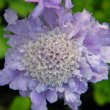

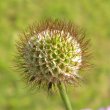
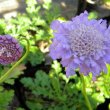
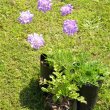
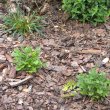


Comments
Scabiosa
Hi, some of my scabiosa have developed white leaves and are not growing. What can be wrong?
Scabiosa sickly
Hi Cath
I would need more information than the brief description above before I can make a diagnosis. Are the leaves themselves turning pure white or are they yellowish? Do they perhaps have a white or greyish coating? If at all possible, send a photo of the ailing plants.
Kind regards
Lorraine
Discuss this plant
Share knowledge, ask a question or give an experience.